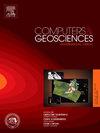Anisotropic resistivity estimation and uncertainty quantification from borehole triaxial electromagnetic induction measurements: Gradient-based inversion and physics-informed neural network
IF 4.2
2区 地球科学
Q1 COMPUTER SCIENCE, INTERDISCIPLINARY APPLICATIONS
引用次数: 0
Abstract
Rapid and accurate petrophysical reservoir description and quantification is important for subsurface energy resource modeling and engineering. Triaxial borehole resistivity measurements enable the estimation of key in-situ rock properties, such as the volumetric concentration of shale and sandstone resistivity. However, traditional approaches for estimating these properties from triaxial, or anisotropic, borehole resistivity measurements rely on analytical solutions that solve a system of equations simultaneously, which can lead to numerical instability and inefficiency. By reformulating the system of anisotropic resistivity equations as an inverse problem, we can achieve a more stable, accurate, and efficient estimation of key petrophysical properties. We propose two methods, namely nonlinear gradient-based and physics-informed neural network (PINN) inversion, to estimate the volumetric concentration of shale and sandstone resistivity from the parallel- and perpendicular-to-bedding-plane resistivity logs, posed as the solution of an inverse problem. Furthermore, we compare the PINN, nonlinear gradient-based inversion and analytical solution methods in terms of accuracy, computational efficiency, and uncertainty quantification using four different datasets of anisotropic resistivity logs, i.e., two synthetic and two field cases. The PINN inversion technique estimates the petrophysical properties within 0.5 CPU milliseconds with an accuracy between 91% and 99%, while nonlinear gradient-based inversion can estimate the petrophysical properties with an accuracy between 98% and 99% but requires several CPU minutes depending on the size of the dataset. The proposed PINN technique is therefore capable of providing fast and accurate estimation and uncertainty quantification of key petrophysical properties from triaxial resistivity logs, with comparable accuracy and approximately speedup compared to nonlinear gradient-based inversion, and can be used for real-time applications such as automatic shale properties estimation, logging-while-drilling measurement interpretation, automated well geosteering, and time-lapse reservoir monitoring.
井眼三轴电磁感应测量的各向异性电阻率估计和不确定性量化:基于梯度的反演和物理信息神经网络
快速、准确的岩石物性储层描述和量化对地下能源建模和工程具有重要意义。三轴井眼电阻率测量能够估计关键的原位岩石属性,例如页岩和砂岩电阻率的体积浓度。然而,通过三轴或各向异性井眼电阻率测量来估计这些特性的传统方法依赖于同时求解方程组的解析解,这可能导致数值不稳定和效率低下。通过将各向异性电阻率方程系统重新表述为一个逆问题,我们可以实现对关键岩石物性的更稳定、更准确、更有效的估计。我们提出了两种方法,即基于非线性梯度和物理信息神经网络(PINN)反演,以估计页岩和砂岩的体积浓度,从平行和垂直于层顺面电阻率测井曲线,作为一个反问题的解决方案。利用4组不同的各向异性电阻率测井数据集,即2组综合数据集和2组野外数据集,比较了PINN、非线性梯度反演和解析解方法在精度、计算效率和不确定性量化方面的差异。PINN反演技术在0.5 CPU毫秒内估计岩石物理性质,精度在91%到99%之间,而基于非线性梯度的反演可以估计岩石物理性质,精度在98%到99%之间,但根据数据集的大小需要几分钟的CPU时间。因此,所提出的PINN技术能够从三轴电阻率测井数据中提供快速、准确的关键岩石物性估计和不确定性量化,与基于非线性梯度的反演相比,其精度可与基于非线性梯度的反演相比提高约106倍,并且可用于实时应用,如自动页岩性质估计、随钻测井测量解释、自动井地质导向和延时油藏监测。
本文章由计算机程序翻译,如有差异,请以英文原文为准。
求助全文
约1分钟内获得全文
求助全文
来源期刊

Computers & Geosciences
地学-地球科学综合
CiteScore
9.30
自引率
6.80%
发文量
164
审稿时长
3.4 months
期刊介绍:
Computers & Geosciences publishes high impact, original research at the interface between Computer Sciences and Geosciences. Publications should apply modern computer science paradigms, whether computational or informatics-based, to address problems in the geosciences.
 求助内容:
求助内容: 应助结果提醒方式:
应助结果提醒方式:


